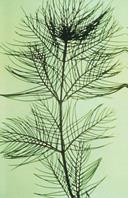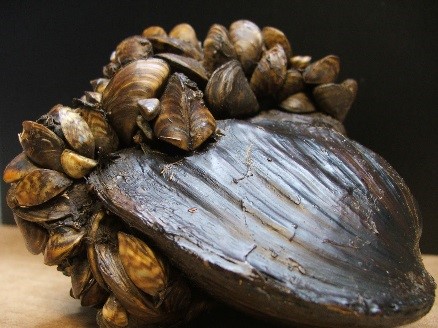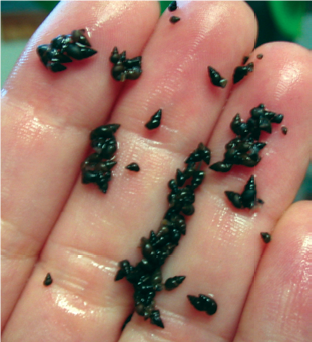You are viewing ARCHIVED content published online before January 20, 2025. Please note that this content is NOT UPDATED, and links may not work. Additionally, any previously issued diversity, equity, inclusion or gender-related guidance on this webpage should be considered rescinded. For current information, visit https://www.blm.gov/blog.
Clean. Drain. Dry
Carmela Romerio, Rangeland Management Specialist, Montana/Dakotas State Office
What Are Aquatic Invasive Species?
Aquatic invasive species (AIS) are those that impact water bodies and wetlands. Whether they come on the trailers or hulls of recreational boats, or from the water of an angler’s bait bucket, several non-native invasive species such as Eurasian watermilfoil and New Zealand mud snails have found their way into Montana’s water bodies. Their presence can cause severe damage to local ecosystems, industry and tourism.
BLM has partnered with Montana Fish, Wildlife and Parks for environmental education and training of public and private stakeholders in Montana who are committed to an effective strategy of prevention, containment and control in Montana’s waterways.
These partnerships also directly support Secretary Zinke’s priority to combat aquatic invasive species.
“Stopping the spread of invasive mussels and increasing our Federal-State-Tribal coordination are both critical priorities in order to ensure that we maintain hydro-power as a clean, reliable, cost-effective source of energy for the West and protect our outdoor tourism economies,” said Secretary Zinke. “Protecting our waterways and ecosystems is not a partisan issue and I’m glad to work with governors as the states, tribes and federal government combat the spread of invasive species. By working as an integrated team to prevent, contain and control invasive mussels, Americans will be able to experience the full benefits of hydro-power and enjoy their rivers, lakes and streams for recreation for years to come.” Secretary Zinke Announces Priority to Combat Aquatic Invasive Species
What Can You Do To Help?
You can help prevent the spread of aquatic invasive species by following these guidelines:
• Report sightings of suspected invasive species to your local BLM, FWP, wildlife agency, parks department, county agricultural office or resource conservation district.
• Learn more about invasive species and invasion pathways. Share what you’ve learned with other people.
• Plant only native plants in your garden or pond.
• Join a community group to remove non-native invaders and restore native habitat.
• Never empty aquariums into rivers, streams, or other waterways, including storm drains—or into any type of wild area. Check with your local pet store for safe disposal options or visit www.Habitattitude.net.
If You Are A Boater or Angler:
• Always follow federal, state, and local laws and regulations.
• Always cooperate with federal, state and local law enforcement officers or other officials managing the water bodies where you use a boat, use check stations.
• Never move live bait or other organisms from one body of water into another, and also don’t dip your bait bucket into one lake if it contains water from somewhere else.
• Carefully check and clean fishing gear, looking closely at the soles and laces of wading boots.
• Always at the conclusion of a boating excursion, “Clean, Drain & Dry” all wet equipment, including the boat, trailer, water toys and associated equipment, and angling equipment, including footwear.
EURASIAN WATERMILFOIL
 Introduced accidentally from Europe, this perennial plant was discovered in the eastern U.S. in the 1940s. Milfoil has since invaded lakes, ponds, and irrigation canals in nearly all 50 states. As with other aquatic weeds, propellers and other boat or trailer parts transport Eurasian watermilfoil between water bodies.
Introduced accidentally from Europe, this perennial plant was discovered in the eastern U.S. in the 1940s. Milfoil has since invaded lakes, ponds, and irrigation canals in nearly all 50 states. As with other aquatic weeds, propellers and other boat or trailer parts transport Eurasian watermilfoil between water bodies.
ZEBRA AND QUAGGA MUSSELS 
These freshwater shellfish are among the most destructive aquatic invaders. Native to Eastern Europe, zebra and quagga mussels showed up first near the Great Lakes in the 1980s, likely via ballast water. They soon spread throughout much of the eastern U.S., and have arrived in the West largely through movement on trailered boats…most dramatically seen with the 2007 discovery of quagga mussels in Lake Mead. Zebra and quagga mussels cause substantial ecological and economic damage by disrupting food webs and clogging water pipes. Billions of dollars have been spent fighting these invaders, and they continue to appear on boats traveling to uninfested states.
This tiny snail was likely introduced to North America by accident in shipments of trout eggs. It was discovered in Idaho’s Snake River in 1987 and has since been found in many western streams and lakes. In some cases, densities exceed 100,000 snails per square meter, displacing native aquatic life. New Zealand mudsnails are effective invaders based on their ability to reproduce by cloning and to seal their shell closed.
 NEW ZEALAND MUDSNAIL
NEW ZEALAND MUDSNAIL
This tiny snail was likely introduced to North America by accident in shipments of trout eggs. It was discovered in Idaho’s Snake River in 1987 and has since been found in many western streams and lakes. In some cases, densities exceed 100,000 snails per square meter, displacing native aquatic life. New Zealand mudsna
ils are effective invaders based on their ability to reproduce by cloning and to seal their shell closed.
Related Stories
- Monument map earns ‘finalist’ honors in global GIS awards
- BLM Fire and National Conservation Lands managers collaborate to meet shared goals
- Recreation for all: Accessibility on Montana-Dakotas public lands
- North Central Montana District employees celebrate new adoption
- BLM Billings Field Office works with state agencies in Montana to conduct bat surveys
